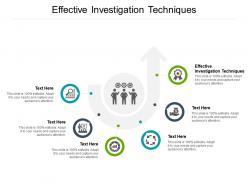Solving The Disappearance: Effective Investigation Techniques

Table of Contents
Initial Response and Scene Management
The initial hours following a reported disappearance are critical – often referred to as the "golden hours." Swift and decisive action during this period significantly increases the chances of a successful resolution. Effective disappearance investigation begins with securing the scene to prevent the loss or contamination of crucial evidence. This involves establishing a perimeter, controlling access, and documenting everything meticulously.
-
Immediate Action: The first responders must immediately begin gathering information from family and friends, establishing a timeline of the missing person's activities leading up to their disappearance. This includes identifying last known location, clothing worn, and any unusual behavior observed.
-
Securing the Scene: Proper scene management prevents the accidental destruction or contamination of evidence. This includes preventing unauthorized access, documenting the initial condition of the scene, and implementing a chain of custody protocol for all collected evidence.
-
Detailed Documentation: Comprehensive documentation is paramount. This encompasses detailed photography and videography of the scene, along with accurate sketches and diagrams showing the layout and any significant findings.
-
Key Actions:
- Establish a chain of custody for all collected evidence, ensuring its integrity throughout the investigation.
- Conduct thorough interviews with family, friends, and neighbors, collecting information about the missing person's routine, relationships, and potential conflicts.
- Utilize specialized search and rescue teams if necessary, employing canine units, drones, and other resources to expand the search area.
- Document all communication and actions taken, including times, locations, individuals involved, and decisions made. This creates an audit trail of the investigation.
Utilizing Technology in Disappearance Investigations
Modern technology plays a crucial role in solving disappearances. Digital forensics, GPS tracking, and surveillance technology offer powerful tools for investigators.
-
Digital Forensics: Examining cell phone data, social media activity, and online searches can reveal crucial clues about the missing person's whereabouts, contacts, and state of mind before their disappearance. This can include location data, communication logs, and browsing history.
-
GPS Tracking and Location Services: If the missing person had a smartphone or other GPS-enabled device, location data can be extracted to pinpoint their last known location and potentially track their movements. This data should be analyzed carefully, considering limitations such as signal strength and accuracy.
-
Surveillance Technology: CCTV footage from nearby businesses, security cameras, or even private residences can provide valuable visual information. Drone technology can also be used to survey large areas efficiently.
-
Technological Tools:
- Employ data analysis tools to identify patterns, anomalies, and connections within the collected digital data.
- Collaborate with tech specialists for complex digital investigations, particularly for encrypted data or sophisticated tracking technologies.
- Understand the legal implications of accessing digital data, adhering strictly to warrants and legal protocols.
- Utilize facial recognition software, when appropriate and legally permissible, to compare images against databases of known individuals or suspects.
Interviewing and Interrogation Techniques in Disappearance Cases
Effective communication is vital in disappearance investigation. This involves skillful interviewing of witnesses and potential suspects.
-
Building Rapport: Establishing trust and rapport with individuals is essential to elicit truthful information. Investigators should be empathetic, patient, and demonstrate genuine concern.
-
Effective Questioning Strategies: Open-ended questions, followed by clarifying probes, are generally more effective than leading questions. The investigator should listen actively and observe body language.
-
Recognizing Deception: Investigators must be trained to recognize verbal and nonverbal cues that may suggest deception. This involves careful observation of body language, inconsistencies in statements, and emotional responses.
-
Best Practices:
- Utilize different interviewing styles (e.g., cognitive interviewing, Reid technique) based on individual circumstances and the personality of the interviewee.
- Document all interviews thoroughly and accurately, including the date, time, location, individuals present, and a verbatim transcript or detailed summary of the conversation.
- Be aware of potential biases and actively strive to maintain objectivity throughout the interview process.
- Consult with experienced investigators and legal counsel to ensure the legal admissibility of all evidence and procedures.
The Role of Psychological Profiling in Disappearance Cases
Psychological profiling can provide valuable insights into the potential motivations behind a disappearance.
-
Understanding Motivations: Profilers can analyze the circumstances surrounding the disappearance, including the victim's personality, relationships, and any known stressors, to develop hypotheses about the possible motives of the perpetrator (if a crime is suspected).
-
Suspect Profiling: Based on the available information, profilers can create profiles of potential suspects, including their likely characteristics, behaviors, and potential connections to the missing person.
-
Risk Assessment: Psychological profiling can help assess the risk level associated with different scenarios, informing investigative strategies and resource allocation.
-
Expert Collaboration:
- Collaborate with forensic psychologists for expert insights into the psychological aspects of the case, including victim profiling and suspect characteristics.
- Use psychological profiling to guide investigative efforts, focusing resources on high-probability leads and avenues of inquiry.
- Consider various psychological factors affecting the case, such as mental health issues, substance abuse, or relationship dynamics.
Collaboration and Information Sharing
Effective disappearance investigation relies heavily on collaboration and information sharing.
-
Inter-agency Cooperation: Sharing information and collaborating with various agencies (local, state, federal, and international) is crucial, particularly in cases involving cross-border movement or complex scenarios.
-
National and International Agencies: Missing persons databases and international networks facilitate the sharing of information across geographical boundaries, connecting cases and potential leads.
-
Databases and Networks: Centralized databases containing information on missing persons can significantly improve the efficiency of investigations by connecting seemingly unrelated cases.
-
Collaborative Strategies:
- Establish clear communication channels between agencies, ensuring the timely and efficient exchange of information.
- Share information securely and efficiently, using encrypted channels and protocols to protect sensitive data.
- Utilize centralized databases for missing persons, such as the National Crime Information Center (NCIC) in the US, to quickly access relevant information.
- Participate in collaborative investigations and task forces, pooling resources and expertise to solve complex disappearances.
Conclusion
Solving a disappearance requires a systematic and comprehensive approach that integrates various investigative techniques. From the initial response and scene management to the use of advanced technologies and collaborative efforts, each stage is crucial in piecing together the puzzle and bringing closure to those affected. By employing the strategies outlined in this article, investigators can significantly improve their chances of successfully resolving disappearance investigations and offering answers to families and communities grappling with uncertainty. Remember, proactive and thorough disappearance investigation, utilizing all available resources and expertise, is key to finding missing persons and bringing justice to those responsible.

Featured Posts
-
 Increased Fungal Threats In A Warming World A Growing Danger
May 26, 2025
Increased Fungal Threats In A Warming World A Growing Danger
May 26, 2025 -
 Deti Naomi Kempbell Foto I Podtverzhdenie Slukhov O Romane Supermodeli
May 26, 2025
Deti Naomi Kempbell Foto I Podtverzhdenie Slukhov O Romane Supermodeli
May 26, 2025 -
 President Snows Casting A 3 Time Oscar Nominee Joins The Hunger Games Prequel
May 26, 2025
President Snows Casting A 3 Time Oscar Nominee Joins The Hunger Games Prequel
May 26, 2025 -
 Rehoboth Beach The Perfect Stress Relief Destination
May 26, 2025
Rehoboth Beach The Perfect Stress Relief Destination
May 26, 2025 -
 Top Tennis Players Boosting Chinas Tennis Culture Italian Open Director
May 26, 2025
Top Tennis Players Boosting Chinas Tennis Culture Italian Open Director
May 26, 2025
Latest Posts
-
 Manchester United In 25m Transfer Battle With Liverpool
May 28, 2025
Manchester United In 25m Transfer Battle With Liverpool
May 28, 2025 -
 Liverpools Pursuit Of Rayan Cherki A Transfer Analysis
May 28, 2025
Liverpools Pursuit Of Rayan Cherki A Transfer Analysis
May 28, 2025 -
 Transfer News Man United Ahead In Race To Sign Rayan Cherki
May 28, 2025
Transfer News Man United Ahead In Race To Sign Rayan Cherki
May 28, 2025 -
 Winning The Euromillions 202m Jackpot What To Expect
May 28, 2025
Winning The Euromillions 202m Jackpot What To Expect
May 28, 2025 -
 Liverpool Transfer Target 25m Players Agent Speaks To Man Utd
May 28, 2025
Liverpool Transfer Target 25m Players Agent Speaks To Man Utd
May 28, 2025
